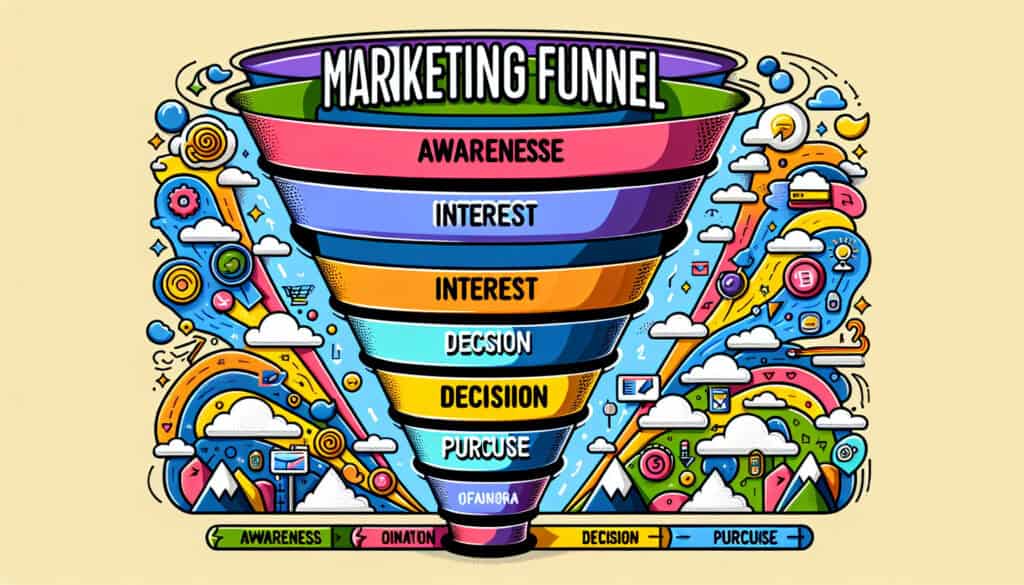To visualize the customer journey from awareness to purchase.
- Methodologien: Herstellung, Projektmanagement
Marketing-Trichter

Marketing-Trichter
- Umrechnungskurs, Kundenerfahrung, Customer Journey Mapping, Marketing, Marketingstrategie, Benutzererfahrung (UX), Benutzerzentriertes Design, Wert-Angebot, Wertstrom-Mapping
Zielsetzung:
Wie es verwendet wird:
- A model that illustrates the theoretical customer journey towards the purchase of a good or service. The funnel is divided into several stages, such as awareness, interest, consideration, and conversion.
Vorteile
- Provides a simple and intuitive way to understand the customer journey; Helps to identify areas where customers are dropping off.
Nachteile
- Can be too simplistic and may not reflect the non-linear nature of the customer journey; Focuses more on acquisition than retention.
Kategorien:
- Kunden & Marketing
Am besten geeignet für:
- Understanding and optimizing the customer journey to increase conversion rates.
Applications of the Marketing Funnel can be found across numerous sectors, including technology, retail, healthcare, and education, where understanding consumer behavior is paramount for driving sales and enhancing customer experiences. Typically utilized during the product development and marketing phases, this model encourages teams to examine each stage in depth, offering a clearer view of where strategic adjustments can increase buyer engagement and conversion rates. For instance, in the tech industry, a product team may employ the funnel model to analyze how potential users first learn about a new app, the content that piques their interest, and the factors influencing their decision-making process before committing to download. Participants in this exercise often include marketing strategists, product managers, and UX designers, all working collaboratively to establish effective communication and marketing strategies at each stage. The simplicity of the funnel allows stakeholders to visualize customer interactions effectively, revealing specific drop-off points—such as a website’s checkout page—where potential consumers lose interest, enabling targeted improvements that can significantly boost sales performance. By integrating analytics tools with the funnel methodology, organizations gain quantitative data that can refine campaigns and enhance user outreach across various platforms.
Die wichtigsten Schritte dieser Methodik
- Define target audience segments based on demographics and behavior.
- Develop strategies for generating awareness through various marketing channels.
- Create engaging content that captures interest and builds a relationship with potential customers.
- Implement tactics that facilitate consideration, such as product comparisons and case studies.
- Optimize conversion through effective calls-to-action and streamlined purchase processes.
- Analyze post-purchase experience to encourage repeat business and referrals.
Profi-Tipps
- Leverage data analytics to continuously monitor conversion rates across each stage and identify drop-off points for targeted intervention.
- Implement A/B testing at various stages to refine messaging, visuals, and calls to action that resonate most with customers.
- Utilize customer feedback loops post-purchase to understand their experience and inform iterative improvements on the funnel stages.
Verschiedene Methoden lesen und vergleichen, Wir empfehlen die
> Umfassendes Methoden-Repository <
zusammen mit den über 400 anderen Methoden.
Ihre Kommentare zu dieser Methodik oder zusätzliche Informationen sind willkommen auf der Kommentarbereich unten ↓ , sowie alle ingenieursbezogenen Ideen oder Links.
Historischer Kontext
1910
1957
1960
1980
1980
1986
1990
1994
1950
1957
1970
1980
1983
1990
1992
(wenn das Datum nicht bekannt oder nicht relevant ist, z. B. "Strömungsmechanik", wird eine gerundete Schätzung des bemerkenswerten Erscheinens angegeben)















Verwandte Artikel
Fragebögen zu muskuloskelettalen Beschwerden
Multivariate Tests (MVT)
Mehrfache Regressionsanalyse
Motion-Capture-Systeme
MoSCoW-Methode
Moods Median-Test